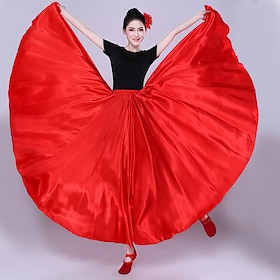Welcome to our webpage dedicated to the captivating world of belly dancing! Belly dancing is an ancient and mesmerizing dance form that has entranced people for centuries. This art form, also known as Raqs Sharqi, offers a beautiful blend of tradition, culture, and self-expression.
Here, we will take you on a journey through the origins, styles, benefits, and how you can get involved in the enchanting world of belly dancing.
The History of Belly Dancing
Belly dancing has a rich history that spans thousands of years. Its origins can be traced back to various regions in the Middle East, North Africa, and the Mediterranean.
Historically, it was a dance performed by women for women, often during celebratory occasions. This dance form has evolved over time, incorporating elements from different cultures and regions.
Styles of Belly Dancing
Belly dancing offers a diverse range of styles, each with its own unique characteristics. Some of the most popular styles include:
Egyptian Belly Dancing
Known for its graceful and fluid movements, Egyptian belly dance is often considered the classic form of the dance. Dancers focus on precise hip and abdominal isolations.
Egyptian belly dancing, often referred to as “Raqs Sharqi,” is a traditional style of belly dance that originated in Egypt. It is considered one of the most classical and elegant forms of belly dancing, known for its precise and controlled movements that emphasize fluidity and grace. Egyptian belly dance is deeply rooted in the culture and history of Egypt and has had a significant influence on the development of modern belly dance styles.
Egyptian belly dancers emphasize smooth and continuous movements that flow seamlessly from one to the next. The dance is characterized by the undulating, serpentine motions of the hips and torso.
Dancers place a strong focus on isolating specific body parts, such as the hips, ribcage, and shoulders. This allows for the intricate and controlled movement of different body regions. Hand and arm movements in Egyptian belly dance are often intricate and convey emotional and narrative elements. Dancers use their hands and arms to tell a story and express various emotions throughout their performance.
Egyptian belly dancers typically wear traditional costumes that include a bedlah (a two-piece bra and skirt set), a hip belt adorned with coins and sequins, and accessories like veils, finger cymbals (zills), and jewelry.
The dance is closely linked to the music, and Egyptian belly dancers are skilled at interpreting the rhythm and melody of the accompanying music through their movements. Live music is often an integral part of traditional Egyptian belly dance performances.
Egyptian belly dance incorporates elements of traditional Egyptian folk dances, such as the Saidi cane dance, the Nubian dance, and the Ghawazee style, into its performances. Egyptian belly dancers often engage with their audience, creating a connection and an immersive experience for those watching.
Turkish belly dancing
Turkish belly dance emphasizes fast and intricate movements, featuring lively music and vibrant costumes. This style is known for its energetic and dynamic performance.
Turkish belly dancing, also known as “Oriental Dance” or “Turkish Oriental Dance,” is a style of belly dance that originated in Turkey. It is known for its energetic, lively, and intricate movements, making it distinct from other belly dance styles.
Turkish belly dance combines elements of traditional Middle Eastern belly dance with the unique characteristics of Turkish culture and music.
Turkish belly dance is characterized by quick, precise, and dynamic movements. Dancers often perform rapid hip and torso shimmies, lively footwork, and fast spins. Turkish belly dance allows for emotional expression and storytelling through the dance movements. Dancers convey a wide range of emotions, from joy and celebration to sorrow and longing.
Turkish belly dancers often incorporate veils, finger cymbals (zills), and other props into their performances. The use of props adds an extra layer of artistry to the dance.
Turkish belly dance costumes are known for their vibrant colors, intricate beadwork, and embroidery. These costumes often include a bedlah (two-piece outfit) adorned with coins, sequins, and tassels. The skirts can be voluminous, and dancers may wear a headpiece with a flowing veil.
Turkish music, especially classical Turkish music, is known for its complex rhythms and time signatures. Turkish belly dancers are skilled at interpreting and accentuating these intricate rhythms through their movements. The music accompanying Turkish belly dance is often upbeat and vibrant, featuring instruments like the darbuka (a type of drum), violin, and oud. Dancers and musicians often perform together, creating a synergy between the dance and music.
Turkish belly dance incorporates elements from various Turkish folk dances, adding a regional and cultural flavor to the performances. These may include elements of the Romani (Gypsy) dance style, the Zeybek (from the Aegean region), and others.
Turkish belly dance is known for its high energy and captivating performances, making it a popular form of entertainment at weddings, festivals, and special events in Turkey and around the world. While it shares some similarities with other belly dance styles, its unique characteristics set it apart and make it a vibrant and culturally rich art form.
American Tribal Style (ATS)
ATS is a fusion style that combines traditional belly dance with elements of Flamenco, Indian, and Middle Eastern dance. It is performed by a group of dancers who use cues and signals to create spontaneous choreography.
American Tribal Style (ATS) belly dance is a contemporary style of belly dance that originated in the United States in the 1970s. It is characterized by its fusion of traditional Middle Eastern belly dance movements with influences from various other dance forms and cultures. ATS belly dance emphasizes group improvisation, a strong sense of community, and a distinctive costuming style.
ATS belly dance is typically performed by a group of dancers who work together to create a choreography spontaneously through non-verbal cues and signals. This allows for a dynamic and interactive performance and group improvisation.
Dancers communicate with each other using a cue system, often involving hand gestures and signals, to coordinate their movements and transitions during a performance. The lead dancer, often referred to as the “FC” or “Focal Center,” guides the group through the dance.
ATS incorporates elements from various dance styles, including Middle Eastern, Romani (Gypsy), Indian, Flamenco, and African dance. This fusion creates a unique and eclectic dance form.
ATS dancers typically wear a distinctive style of costume that includes choli tops, full skirts, and belts adorned with coins, mirrors, and tassels. The use of tribal jewelry and textiles adds to the overall aesthetic. ATS dancers may incorporate various props like veils, swords, fans, and even fire dancing into their performances, further adding to the visual spectacle.
Dancers often wear finger cymbals, known as zils, which are used to create rhythmic accompaniment to the music and enhance the auditory aspect of the performance. ATS typically features live or recorded music with a strong rhythm, such as Middle Eastern and North African percussion, as well as various ethnic and fusion music genres.
ATS emphasizes the importance of a tight-knit community of dancers who collaborate and support each other. The dance style fosters a sense of sisterhood and camaraderie.
ATS belly dance has gained popularity in the belly dance world and is known for its powerful and evocative performances. It has evolved over the years, leading to the development of variations like American Tribal Style belly dance (ATS) and Tribal Fusion belly dance. These variations incorporate even more eclectic influences and have been adopted by dancers and troupes worldwide, contributing to the ever-evolving landscape of belly dance.
Fusion Belly Dance
Fusion styles blend belly dance with other dance forms like hip-hop, contemporary, or ballet, creating a contemporary and unique expression of the art.
Fusion belly dance is a contemporary and innovative style of belly dance that blends traditional Middle Eastern belly dance with elements from various other dance forms and cultural influences. Fusion belly dance is characterized by its creative and experimental nature, encouraging dancers to incorporate movements, music, and costuming from different traditions to create a unique and personal dance style.
Fusion belly dance incorporates elements from a wide range of dance styles, such as hip-hop, contemporary, ballet, jazz, flamenco, Indian dance, and more. This fusion allows for an eclectic and diverse range of movements and expressions.
Fusion belly dancers often select music that goes beyond traditional Middle Eastern and North African rhythms. They might use electronic, world music, or modern remixes to create a contemporary and dynamic soundtrack for their performances.
Fusion belly dance costumes can vary widely, reflecting the fusion of different cultures. Dancers may combine traditional belly dance elements with attire from other dance styles or create entirely new and imaginative costumes.
Fusion belly dance offers dancers the freedom to blend choreographed movements with spontaneous, improvisational elements. This allows for creative expression and adaptability during performances. Fusion is open to experimentation and encourages dancers to push the boundaries of traditional belly dance to create something fresh and innovative.
Fusion belly dancers often incorporate a wide range of props such as silk fans, LED lights, poi, and more into their acts, adding a modern and visually captivating element to their performances.
Fusion belly dance is influenced by various global dance traditions, bringing together elements from diverse cultures to create a rich and inclusive art form. Fusion belly dance emphasizes individuality and personal expression, encouraging dancers to explore their own creativity and unique style.
Fusion belly dance has gained popularity in recent years, with dancers and choreographers pushing the boundaries of the art form to create visually striking and emotionally engaging performances. This style of dance allows for a great deal of artistic freedom and has contributed to the evolving landscape of belly dance, making it more inclusive and adaptable to contemporary audiences.
Benefits of Belly Dancing
Belly dancing is not only a beautiful form of expression but also offers a range of physical and mental benefits:
Fitness: Belly dancing is a full-body workout that improves flexibility, strength, and cardiovascular health.
Self-Confidence: It fosters self-confidence and self-expression, allowing individuals to feel more comfortable in their own skin.
Stress Relief: Dancing is a great way to reduce stress and boost mood by releasing endorphins.
Cultural Appreciation: Learning belly dancing can lead to a deeper appreciation of Middle Eastern and North African cultures.
Getting Involved
Interested in trying out belly dancing? Whether you’re a beginner or an experienced dancer, there are various ways to get involved:
Look for local belly dance classes or workshops in your area, both in-person and online. Join online forums, social media groups, or local belly dance communities to connect with other enthusiasts.
Explore books, videos, and tutorials to learn more about this captivating art form. Enjoy the mesmerizing performances by professional belly dancers to gain inspiration and appreciation for the dance.
Belly dancing is a beautiful, empowering, and culturally rich art form that has captured the hearts of people worldwide. By understanding its history, exploring its styles, and experiencing its benefits, you can embark on a fascinating journey into the world of belly dance.
Whether you’re interested in learning or simply appreciating the beauty of this art form, there’s a place for everyone in the enchanting realm of belly dancing.
Related feature stories
Fascinators: Elevating Your Style With Elegance
Darbuka Drums: The Rhythmic Heart of Middle Eastern Music
Discover The Mystical World Of Handpans
Was courtesan Mata Hari really a spy?










